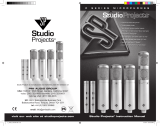
-3-
Superlux D401S is an Omni directional, dynamic microphone with no
proximity effect. With its inherent uniform sensitivity, and flat on-axis
response that provide articulate speech for interview, broadcast, or
podcast.
Very suitable for recording only application, so there is no feedback concern
or coloration.
Multiple vibration reduction system that reduce handling noise to minimum.
Sleek profile for comfort handling and visual effect, and enhancing wind
Description
! Omni directional, uniform sensitivity. Balance and nature sound.
! Low impedance, high dynamic range.
! Spherical pick-up, capturing all related message.
! Strengthen metal grill, sturdy die-cast shaft for maximum impact
protection.
! On/off mute switch.
! Especially suitable for interview, speech recording, communication,
language education etc.
Features
Accessories
Supplied accessories
Microphone clip ------- ---- -------- HM38S-------- ----------------
HM38S
Microphone clip
User Guide
G O A N G - F A N N C O . , L T D .
© 2007, SUPERLUX I
LB100D40101EN (Rev. 1)
nc.
-1-
Specifications
Dynamic microphone
Type
Polar pattern
80 to 15,000 Hz (Figure 2)
Frequency response
Sensitivity (at 1,000 Hz Open Circuit Voltage)
200Ω
Rated impedance
Omni-directional, rotationally symmetrical about microphone axis,
uniform with frequency. (Figure 1)
J U S T P L A Y I T
Omni Microphone
-54dBV/Pa (2.0mV/Pa) 3dB , 1Pa=94dB SPL±
D401S
Finish
Integral 3 pin male XLR type
Connector
Metal construction with Grey body and champagne-silver housing
painted finish
The D401S operates between -10℃ to +50℃(14℉ to 122℉) with
relative humidity between 0 to 95%.
Environmental conditions
Net weight
Dimensions
280.0 grams (9.9 oz)
The D401S including the product and packages follow the instruction
of EU 2002/95/EC and comply to RoHS.
RoHS
Φ47.0mm x 174.0mm (1.85in. x 6.85in.), Figure 3
-2-
Dimensions (Figure 3)
TYPIC AL POLAR PATTERN (Figure 1)
TY PICAL FR EQUENCY RESPONSE (Fi gur e 2)
8000 Hz
16000 Hz
1000 Hz
2000 Hz
4000 Hz
FREQUENCY IN Hz
Frequency Response
RELATIVE RESPONSE IN dB
dB
10
-10
-20
20 50 100 200 500 1000 2000 5000 10000 20000 Hz
0

-5-
Type of transducer
About Frequency Response
Suitable for working at controlled environment, or for acoustic measurements.
Although people persuit flatness, but for none-professionals, it is a challenge to makes
it works as expectation.
Flat
Based on years of practical experience of pro users. There are curves to be build for
various applications, so that it is very simple to use the microphone for the purpose.
Limiting bandwidth, and emphasing are typical skill.
Popular curve response
Incorporating switchable filters to elliminates interference, such as sub-sonic filter to
cut air-conditioner and floor vibrations. And allows full flat when used in controlled
environment.
Variable response
Directivity
-4-
-6-
Knowing your microphone
Superlux provides variety selection of microphones for professionals and amatures. To
know your microphone is the first step to successful result.
Mounting the microphone
Maintainence
Pressure gradient microphone is very sensitive to vibration. Suitable shock mount for
high performance microphone is necessary for extreme low noise recording. Sturdy
stand can set the microphone excatly at the sweet spot and keep it there. Choose heavy
duty microphone stand for studio condenser microphone which weights much more
than handle microphone.
Superlux provides wide range of microphone stands for various demands. Big Foot
Willie is specially developed for large condenser microphones that able to support 2
large microphones with stereo bracket for single point stereo recording.
Extension foot on all the 'E' versions serve to mount heavy studio microphone in limit
space live sound applications.
Using a handheld microphone
For best signal to noise ratio, distance from the handheld microphone to the sound source
shall be as short as possible.
For higher gain before feedback and lowest background noise, the microphone shall be
pointed directly to the sound source. (refer to the illustration below) The sensitivity of a super
cardioid microphone is highest on axis and lowest at 120 to 135 degrees.
To avoid interference between multiple microphones, each sound source shall be picked-up
by one microphone, use as less microphones as possible in one space, or turn-on as less
microphones as possible at the same time.
To reduce crosstalk between microphones, an 1:3 guide line shall be follow: The distance
between microphone A to the sound source A is "1", the distance between any other
microphone to the sound source A shall be more than 3 times.
When the (super) cardioid microphone get closer to the sound source, the low frequency
response is boosted, as so call "proximity effect". Experience singer takes advantages of the
proximity effect to improve the richness of his/her voice or to increase the bass of the
instrument as if an extremely high quality equalizer is used. Same idea to reduce the bass by
increase the distance to reduce the bass when needed.
Reflecting surface affect sound as well. Beware of these surfaces such as wall, table, or floor.
Place the microphone away from the hard surfaces or directly contact these surfaces to form a
pressure zone microphone.
When using the microphone outdoor or in windy environment, additional foam wind screen
helps to reduce wind noise.
Keep grill pop screen clean to avoid degrading the sound quality. Do not expose the
microphone at high humidity/temperature environment to avoid damage.
Dynamic microphone shall be kept in low humidity environment for best sound
performance. Store the condenser microphones in airconditioned room or dehumidifier
to keep away form moisture. Clean air is another important factor. Keep away from
smoking environment to avoid tar residuals.
Durable and simple structure, operates in all kinds of environments. A good dynamic
microphone is capable to operate at very high sound pressure level without distortion.
Due to structure limit, dynamics cannot be built as small as condenser, but dynamics
doesn require power to operate.
Dynamics
90°
20-50mm
180°
0°
90°°
120 ~135° °
120 ~135° °
Monitor
Loudspeaker (s)
P.A. System
Loudspeaker
Recommended
Loudspeaker Locations
Equal sensitivity to all direction, so that the microphone doesn't need to pointing
toward the sound source. Low handling and wind noise. Welcome by news gathering,
and music recording applications.
Omni
Distance to source
Close miking or distant miking sound very differently. Vocal recording or live
performance practice close miking mostly. Suitable proximity effect is one desired
target, and lower feedback problem is another factor for live sound application.
While distant miking is common practice for recording, especially stereo pair
recording with large group of performers, such as orchestra or choir.
Distant miking generally picks up less bass section with pressure gradient type of
microphone (cardioid, figure-8, shotgun...) due to acoustic nature and lack of
proximity effects.
Rich bass with distant miking can be recorded with pressure type of microphone
(Omni), which performs the same frequency response with close or distant pick-up.
Optional accessories
Gooseneck mic base ----------- ---- -------- DS003A
Table stand -------------------------------------------------- HM6
Table stand -------------------------------------------------- D1
Gooseneck --------------------------------------------------- GM13G
------ -----------
D1
Table stand
GM13G
Gooseneck
XLR3F to XLR3M
HM6
Table stand
DS003A
Gooseneck mic base
/


